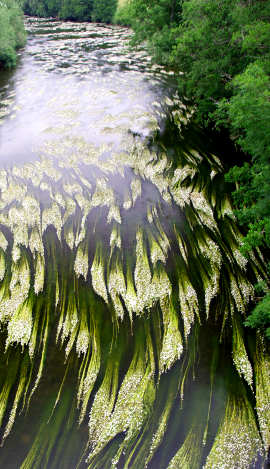
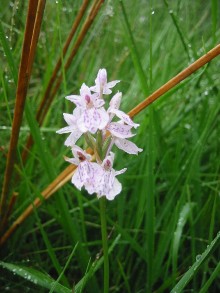
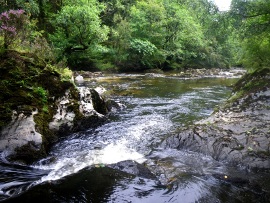
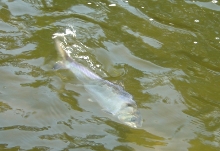
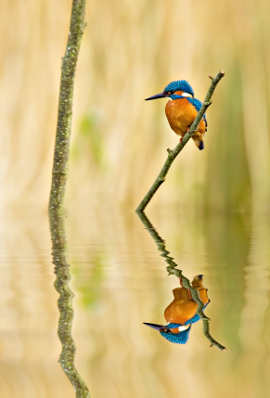
Ecology
The Irfon system is of special interest for its medium and low nutrient river plant types, which include communities containing water crowfoot Ranunculus spp. It supports important populations of rare river and aquatic lichens (including river jelly lichen Collema dichotomum), and other species such as otter Lutra lutra, Atlantic salmon Salmo salar, bullhead Cottus gobio, brook lamprey Lampetra planeri, river lamprey Lampetra fluviatile, sea lamprey Petromyzon marinus and twaite shad Allosa fallax. Allis shad Alosa alosa are probably present.
The headwaters support ultra nutrient poor aquatic communities and extensive areas of semi- natural riparian habitats can still be found next to the river and its tributaries. These include semi-natural woodland, dry and marshy grassland, stands of tall fen and marsh vegetation and gravel banks. The site also includes back channels and oxbows that support otters and waterfowl and provide valuable refuges for small fish and invertebrates in times of flood.
At the start of the project the Irfon upstream of Llanwrtyd was acidified. Aquatic plants are still scarce here but the moss and liverwort flora well developed. Marginal plants include sneezewort, lady fern, sedges, lemon-scented fern, lesser spearwort Ranunculus flammula, bog mosses, marsh violet and the locally uncommon globe flower.
The lower reaches of the Irfon support plant communities that are typical of moderately nutrient-rich waters. Typical aquatic plants include alternate water-milfoil, small pondweed, stream water-crowfoot (Ranunculus penicillatus subsp. Pseudofluitans), the mosses and filamentous algae. Rocks in the flood zone support species such as the nationally scarce wild chives and numerous species of rare mosses, liverworts and lichens, including river jelly lichen. Marginal species here include marsh marigold, water mint, butterbur, reed canary- grass wood club-rush and unbranched bur-reed. Further upstream, the water chemistry is slightly less nutrient-rich and the dominant aquatic plants are the mosses and filamentous algae, although stream water-crowfoot continues to grow as far upstream as Llangammarch Wells. Mosses remain prominent in the riparian zone and common marginal plants include creeping bent, common spike-rush, soft rush, hemlock water- dropwort, reed canary-grass and bog stitchwort. Most of the main tributaries support similar plant communities to the middle reaches of the Irfon but the Cledan has a very gentle gradient and is strongly influenced by the peat deposits in its catchment. Characteristic aquatic plants here include intermediate water- starwort, alternate water-milfoil, floating bur-reed floating sweet-grass and round- leaved crowfoot Ranunculus omiophyllus.
Woodland is widespread along the river and stream banks, dominated variously by alder willow, ash and oak. Wet areas that are protected from grazing stock support vegetation dominated by meadowsweet, with frequent wild angelica, common valerian, common marsh bedstraw, ragged robin and greater bird's-foot-trefoil. Grassland dominated by bents and fescues is common, particularly along the upper reaches of the system, whilst wetter pasture is largely dominated by rushes and purple moor- grass. Old back channels contain swamp vegetation, which includes rushes, floating sweet-grass, tall sedges and yellow iris. Partly vegetated shingle occurs throughout the river system and supports a range of characteristic plants including nodding bur-marigold, marsh cudweed, toad rush, monkeyflower, water pepper, procumbent pearlwort and colt's-foot.
The upper Wye and its tributaries (including the Irfon) support one of the strongest populations of otters in England and Wales. This species is threatened by habitat destruction, disturbance and pollution throughout its European range and is specially protected. Otters rely on woodland, scrub and tall bankside vegetation for cover. Resting holts may often be found amongst the roots of large trees at the water's edge, whilst breeding holts are often located in dense cover on the river banks.
Freshwater pearl mussels (FWPM) inhabit the middle and lower reaches and the project has found that the Irfon supports one of the best populations of this rare species in Wales. They rely on sufficient numbers of salmon and trout in the river to be able to increase their numbers and low levels of fine sediment in the gravels for the early life stages to survive.
A range of fish species inhabits the Irfon and its tributaries. The system provides important spawning areas for Atlantic salmon and juveniles are present throughout, including the reaches upstream of Llanwrtyd Wells that were acidified before the ISAC project begun. Brook and river lamprey are present in the main river and also spawn in the tributaries. Bullhead are abundant everywhere where the pH is greater than 6.0 and twaite shad spawn in the lowest 4km. Brown trout are widely distributed and are believed to exhibit considerable genetic diversity.
The site supports a range of breeding birds that are associated with riparian habitats, including grey heron, common sandpiper, grey wagtail, dipper, kingfisher and sand martin. The river and bankside trees support large populations of flying insects, which provide an important food source for bats, including Daubenton's bat. The invertebrate fauna has not yet been studied in detail but there is a population of white clawed crayfish Austropotamobius pallipes in the lower reaches of the main stem and some lower tributaries.
For more information on some of the Irfon's species and how the ISAC project is benefitting them, please see the Species section.
